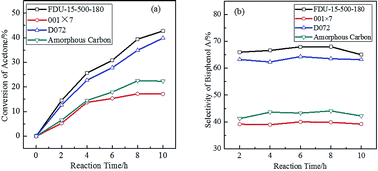A novel highly ordered mesoporous carbon-based solid acid for synthesis of bisphenol-A
Abstract
A novel highly ordered mesoporous carbon-based solid acid was prepared through controlled sulfonation of F127 type mesoporous carbons prepared via a solvent evaporation induced self-assembly method. The influence of sulfonation temperature was investigated, suggesting an optimum temperature of 180 °C. The sulfonated samples were characterized by means of N2 adsorption–desorption, XRD, TEM and FT-IR. The SO3H group-functionalized mesoporous carbon showed a specific surface of 393 m2 g−1, pore volumes of 0.33 cm3 g−1, an average pore size of 3.7 nm and a SO3H group density of 1.71 mmol g−1. The mesoporous carbon-based solid acid effectively catalyzed the condensation of phenol with acetone. The increased catalytic performance was attributed to a uniform mesoporous structure and hydrophobic surface properties.


 Please wait while we load your content...
Please wait while we load your content...